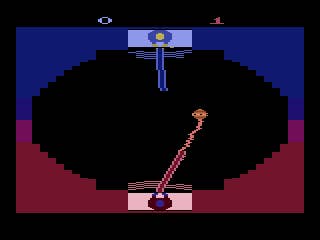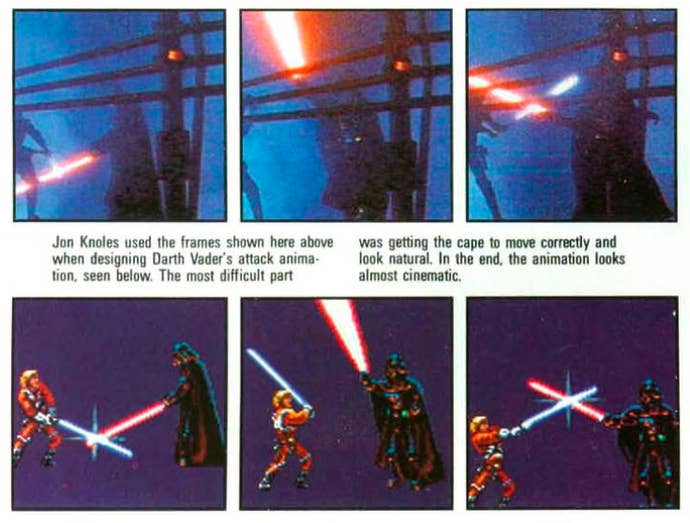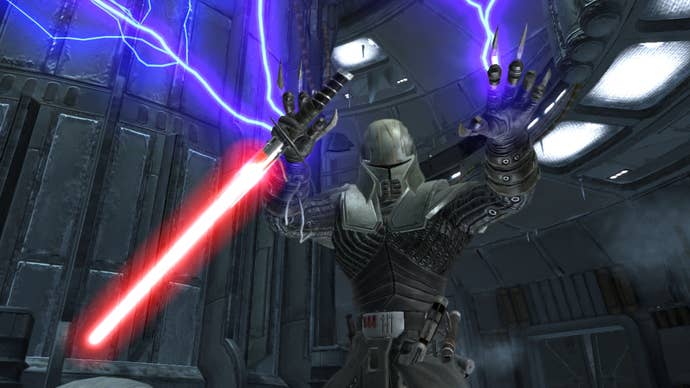The 35 Year Quest for the Perfect Video Game Lightsaber
Tracing the history of the iconic weapon from the Atari 2600 to the present, and all the ways that it's influenced gaming.
This article first appeared on USgamer, a partner publication of VG247. Some content, such as this article, has been migrated to VG247 for posterity after USgamer's closure - but it has not been edited or further vetted by the VG247 team.
This article originally ran shortly after the release of Jedi: Fallen Order. We're bumping it once again to celebrate "May the 4th."
What is it about the lightsaber? For decades now, the ancient weapon of the Jedi has had an iron grip on the popular imagination. It's everywhere: in toys, in popular media, in games. When Disney opened its Star Wars: Galaxy's Edge attraction at Disneyland, everyone gushed over the ability to build their own customized lightsaber (for $200).
So why do people love lightsaber so much? Well, for starters, it's a laser sword, which is cool in itself. It also has a distinct look about it, with individual colors helping to define the personality of its wielder—who can forget Mace Windu and his purple lightsaber? Igniting a lightsaber produces a distinctive thrum, the product of idling interlock motors in aged movie projectors, as well as interference caused by a television set on a shieldless microphone. It's a pleasingly industrial sound that conveys a sense of danger and power.
All of this has helped burn the lightsaber into the pop culture consciousness for the better part of 40 years. In that time, game developers have done their best to capture the appeal of Star Wars' "elegant weapon from a more civilized age," the most recent example being Respawn's Star Wars Jedi: Fallen Order. Their efforts have been met with mixed success. No matter how powerful the technology, games have been dogged by the same persistent issue: lightsabers are just too strong.
In the films, lightsabers are practically unstoppable. They can block blaster bolts; they can be thrown and guided using the Force, and they can melt through giant steel blast doors. The first time we truly see a lightsaber in action, it's used to carve up a belligerent Aqualish thug in the Mos Eisley cantina. The sight of a bloodied and severed arm lying on the ground is proof enough that the lightsaber is not a weapon to be trifled with.
Still, that hasn't stopped developers from trying. From the Atari 2600 to the SNES, and on to the PC and modern consoles, lightsaber combat has seen many different interpretations in games—some good, some quite bad. Even the best of them have at least a few compromises, but they nevertheless represent halting steps toward not just improving lightsaber combat, but the action genre as a whole.

The Beginning: Star Wars: Jedi Arena (1983)
The first real example of a lightsaber video game is probably Star Wars: Jedi Arena, an Atari 2600 game built around the famous scene in which Luke Skywalker practices deflecting shots from a robotic remote. As a first effort, it's rather uninspiring. Despite the name, you never actually battle one another. Instead, you use the control paddle to block what appear to be lightning bolts from a floating ball in the middle of the screen.
It was probably neat for the time, as the extremely limited technology of the period made it all but impossible to make a fully-realized lightsaber game. Most of the Star Wars games of the period were instead based around the original trilogy's famous space battles, most notably the trench run—another video game holy grail. As most games of the era were space shoot 'em ups, it only made sense to stick players in an X-wing.
As for Jedi Arena, it was basically Pong with a laser sword. Not terrible, but maybe not the most auspicious start for the lightsaber game sub-genre.

Refinement: Super Empire Strikes Back (1992)
Now this is more like it. The advancement of graphics into the 16-bit era made more faithful depictions of the lightsaber possible. Super Star Wars, which envisioned A New Hope as a 16-bit platformer, had a lightsaber, but it was Super Empire Strikes Back where developers started to get really ambitious.
The Empire Strikes Back's best-known setpiece is Luke's first ever duel with Darth Vader, a beautiful multipart battle that takes them through the bowels of Cloud City and ends with Darth Vader's famous reveal: "No, I am your father." In the September 1993 issue of Nintendo Power, LucasArts developer Jon Knoles discussed the process of capturing that famous battle, juxtaposing the animations in the game with actual scenes in the movie. The hardest part to get right? Darth Vader's cape, apparently.
The finished product looks a bit stiff by today's standards, but for the period it was a glorious rendition of one of cinema's most iconic battles. Luke's lightsaber slash gets repetitive, but when it connects with Vader's blade, it looks like they're clashing just like in the movies. Of course, you're not given much time to admire these flourishes, as Super Empire Strikes Back is hard. You have to be quick to avoid Darth Vader's long reach, and his long lifebar makes the duel a battle of attrition. In the final area, he pulls in junk from all angles, most of which is next to impossible to block or avoid.

Still, Super Empire Strikes Back and the other games in the trilogy tend to be fondly remembered as the first really faithful Star Wars games on consoles. They were technological showcases that showed off the full range of the Super Nintendo's capabilities, from the Mode-7 X-wing flight across Bespin to Luke's climactic duel with Darth Vader. Even today, Super Empire Strikes Back looks quite cool in static screenshots.
But they hit on an issue that would prove to be a long-lasting problem for Star Wars games: actually striking enemies with a lightsaber wasn't that satisfying. Often it would take more than one hit for a foe to go down; and when they did, they sort of exploded in a way that felt very much like… well… a video game. It would be an issue that games would continue to grapple with in the present day.
Breakthrough: Dark Forces 2: Jedi Knight (1997)
The next big breakthrough for the depiction of lightsabers in games was on the PC. In 1995, LucasArts released Dark Forces, a game that attempted to translate the success of Doom into the Star Wars universe. It was ultimately well-received, but fans and critics alike voiced disappointment in the lack of lightsaber combat.
LucasArts responded with Dark Forces 2: Jedi Knight—a first-person shooter that also incorporated a lightsaber. On paper, it was an awkward fit. The mouse and keyboard combo didn't really offer the flexibility to recreate Star Wars' famous duels, and the perspective was restrictive. In the hands of a lesser developer, it might have been a disaster. Instead, Jedi Knight is often lauded as one of the best shooters ever made.
The implementation of the lightsaber in Jedi Knight is simple but elegant. You get two attacks: light and strong. Light attacks can be used to quickly hack down enemies, while strong attacks produce a wide swing more useful for groups. It's harder to use than a standard blaster, but it is also far more powerful, able to hack down both powerful AT-STs and kell dragons. Once you get the hang of it, which takes a while, you almost never want to go back, as it's fun to just run through and hack off the arms of hapless Stormtroopers foolish enough to get in your way.
The lightsaber in Dark Forces 2 wound up being the foundation for probably the most successful depiction of the lightsaber this side of Fallen Order. It was further refined in Jedi Outcast, which added fast, medium, and slow styles featuring different animation styles, each one useful for different types of enemies. Jedi Academy would subsequently add dual lightsabers and double-bladed lightsabers in response to the prequels.
In a 2017 Youtube retrospective, former Raven Software programmer Mike Gummelt revealed that the influence for Jedi Outcast's combat was Bushido Blade, the classic PlayStation 1 arena fighter in which weapons are almost instantly lethal. "[In Bushido Blade], you pick your weapon and you just kind of pace back and forth. You walk around each other, and then you just kind of run at each other and attack. And you might just kill each other in one hit, but a lot of it is the pacing and spacing and when you're going to attack. I wanted it to be like that and less like a fighting game or a button masher," he explained.
Multiplayer dueling in Jedi Academy proved so popular with fans that it still has a dedicated fanbase to this day. Much of that is owed to the Movie Battles 2 mod, a class-based total conversion featuring heroes including Boba Fett, Luke Skywalker, and even the new trilogy's Kylo Ren. "I'd say the community really owns the game now," Gummelt said.
Looking back, Jedi Academy may still be the best all-around depiction of lightsaber combat in a video game. While it doesn't quite replicate the look and feel of the movies—you spend a lot of time dancing around your foes in a kind of delicate ballet, rather than actually clashing with them—it gets just close enough to feel "right." It's aided by appropriately powerful weapons that can rapidly cut through basic enemies, customization options that allow you to build your own Jedi from scratch, and its status as one of the few Star Wars games to include dual-wield lightsabers. Dated as it may look, it's still the gold standard for multiplayer lightsaber combat, and you can even play it on Switch now.

A Weird Interlude: The Motion Control Era
While LucasArts revolutionized lightsaber combat on the PC side, the console side remained rather stagnant. Masters of Teras Kasi was a rather uninspiring fighting game for PlayStation in which lightsabers were effectively worthless. Jedi Power Battles was a basic platformer (though you could chop of the heads of droids), and Lego Star Wars was more focused on being a collect-a-thon than on meaningful combat. Then came the Wii, which proved to be an odd interlude in the history of lightsaber games.
The drumbeat for a lightsaber game began almost as soon as the Wii was announced. Being able to actually swing around a lightsaber was a tantalizing fantasy, and the Wii Remote seemed well-suited for the realization of that dream, even featuring a speaker from which the characteristic "buzz" the lightsaber could emit. No More Heroes, a vulgar action game by Goichi Suda, managed to gain traction almost solely because it happened to (sort of) have a lightsaber. But when the actual Star Wars games arrived, they didn't live up to the hype..
Krome Studios was the first to take a crack at making a proper Wii lightsaber game with Star Wars: The Clone Wars - Lightsaber Duels. The result was a generic fighter with stiff animation and repetitive waggle controls. Some of the ideas were sound, such as mapping the Force controls to the nunchuk, but the decision to make a third-person action game with a distant camera made it feel curiously unmoored from the Wii Remote's inputs.
Lightsaber Duels developer Krome Studios would get another chance with The Force Unleashed for the Wii. It was received a bit better, with the motion controls being one of the areas to receive praise, but it was slammed for its lack of polish. "Most of the Jedi battles end up being the highest points of the game, as they can be extremely cinematic and immersive. At the same time, you'll often be battling camera problems and the lock-on issue as you try to use parts of the world to your advantage, or dodge and block incoming force attacks from your enemies," wrote IGN reviewer Mark Bozon.
Ultimately, the Wii was probably too limited to really do the lightsaber justice. Current VR iterations like Lightblade VR show more potential, but they aren't much more than basic demos at the moment. Oddly, the single best lightsaber game in VR right now might be Beat Saber, which combines the fun of swinging a lightsaber with the rhythm genre. It isn't Star Wars, but at least it's more than fun than Lightsaber Duels.

A Step Back: Star Wars: The Force Unleashed
By the time the Xbox 360/PS3 era rolled around, Star Wars was at the lowest point it had been in quite some time. Its reputation had declined in part because of the prequels, and because of a slew of poorly-received licensed efforts by LucasArts. To right the ship, LucasArts decided to go all in with a blockbuster action game that would serve as a technical showcase for the series while also telling a new story in the Star Wars universe.
The result was Star Wars: The Force Unleashed, an action game built on the foundation of the then-new Havok engine, which made it possible to play all kinds of physics-based tricks on Stormtroopers using the Force. Its main character, Starkiller, wielded a lightsaber, but the fun was mostly in picking up ragdoll Stormtroopers and watching as their compatriots reacted in horror. The lightsaber was derided as a "nerf bat" by fans and critics, as it often took multiple hits to kill even basic enemies.
This had the unintentional side effect of sapping away the fun of using the Force on your enemies. After all, the lightsaber and the Force are both ingredients in the fantasy of being a Jedi. You could say that emphasizing one over the other brings the Force out of balance.
In any case, while Force Unleashed received okay reviews, it hasn't aged well. Now that its graphics are no longer best-in-class, the boring combat, weird ragdoll animation, and other deficiencies stand out even more. A 2010 sequel was widely panned by critics for feeling short and unfinished, and then three years later, LucasArts abruptly stopped making games. With EA at the helm, it would be six long years before fans saw another single-player Star Wars with a lightsaber playing a central role.
The Present Day: Jedi: Fallen Order
"It's a problem," Respawn lead technical designer Brandon Kelch said of lightsabers earlier this year. "The lightsaber should kill things. But also, killing everything in one hit doesn't feel good as a game."
Kelch was responding to questions about Jedi: Fallen Order, which had just debuted at E3 2019. Respawn was promising a Star Wars game that would combine the best elements of Metroidvania-like exploration and Dark Souls-like combat. But as always, capturing the appeal of the lightsaber without making it overpowered was a big potential stumbling block.
Respawn's solution was to make blocking a core component of the combat. If you could break through a Stormtrooper's guard, you could finish them off with a dynamic kill animation. In a departure from Jedi Knight, dismemberment was deemphasized, but alien creatures and droids could be chopped up at will.
The end result is definitely the best lightsaber game since Jedi Academy. I wrote in my review that combat is where Fallen Order succeeds most brilliantly, "[Fights in Jedi: Fallen Order] demand precision, strong pattern recognition, and the full use of your constantly evolving moveset, or you will be mulched."
Like Jedi Academy, it also understands how personal a lightsaber can be.
I certainly have my issues with Jedi: Fallen Order. The lack of fast travel is a pain, the glitches make it feel unfinished, and the end is jarring to the point that it feels as if Respawn ran out of money and had to pull the plug. But as I wrote in my review, it's surely the most enjoyable action game I've played all year.
Looking back on the 36 year history of lightsabers in games, I'm struck by how difficult it's been for developers to capture the look and feel of one of cinema's most iconic weapons. Even Fallen Order, which makes a strong argument for being the most faithful realization of the lightsaber to date, has to make concessions to the reality that you shouldn't be able to cut down bosses in one hit. The precise element that makes the lightsaber so cool—its raw power—is also what makes it so hard to realize.
But game developers will keep trying, which is good for action games as a whole. The harder they press to get the lightsaber right, the further they will push the boundaries of the genre, paving the way for higher-quality action games to come. In that sense, even if we never get our "perfect" lightsaber game, the struggle will have been worth it.











